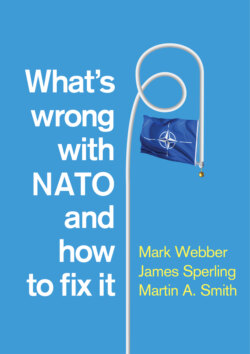Читать книгу What's Wrong with NATO and How to Fix it - Mark Webber - Страница 21
Strategic Overload
ОглавлениеBut the accumulation of tasks also has its downsides. NATO has taken on more than it can cope with and it makes claims to competence it cannot possibly fulfil. This problem of ‘overload’ was identified by the political scientist Anthony King back in the mid-1970s when analysing the growing demands placed upon domestic governments.8 It is a problem that also applies to international organizations. Overload has informed much of the debate on NATO’s post-Cold War evolution. As the Alliance has moved forward, scholars, think-tank analysts and politicians have lined up either to praise its adaptive creativity or to warn against over-stretch and a dilution of purpose. The latter position focuses on the downsides of NATO’s acquisition of new tasks, and its absorption of new members through enlargement.
During the 1990s, NATO took decisive steps on both counts. It adopted the Partnership for Peace (PfP) programme in January 1994, launched an air campaign and peacekeeping mission in Bosnia, signed the Founding Act with Russia in May 1997, and in 1999 welcomed the Czech Republic, Hungary and Poland as new members. In March 1999, meanwhile, NATO launched Operation Allied Force (OAF) – a seventy-eight-day aerial bombing campaign that dislodged Serbian forces from Kosovo. The Alliance was thus in the thick of the action, but as the decade ended, some observers argued that it was now doing too much. NATO, Michael E. Brown argued, had become ‘preoccupied with activities unrelated to vital interests’. The high costs of military operations and the likelihood of serial failures, he suggested, threatened to inflict ‘irreparable damage’ upon it.9
As NATO moved into the 2000s, it acquired more new members (seven states joined in 2004) and more tasks. The operation in Afghanistan was the Alliance’s most significant undertaking after 9/11, but NATO also staked out a broader counter-terrorism role and extended its partnership programmes beyond the former communist states and the Mediterranean to embrace the Gulf region as well as a diverse group of ‘partners across the globe’ that included Japan, Australia and New Zealand. A lack of strategic and operational focus now emerged as a real problem. The Alliance, Beatrice Heuser suggested in 2002, was in danger of ‘becom[ing] so amorphous and so ill-defined that it will be useless for anybody’.10 Six years later, the UK House of Commons Defence Committee noted similarly that NATO’s diversification had made its ‘role and purpose’ unclear both to its members and to its citizens.11
The Alliance at that point was certainly very busy. But as its own Secretary General, Jaap de Hoop Scheffer, noted, the sheer range and difficulty of missions meant its resources were stretched as never before.12 As defence budgets plunged in the aftermath of the 2008 global financial crisis, this would become a recurrent theme. According to the 2010 NATO Parliamentary Assembly, several allies were of the view that ‘NATO is already stretched beyond its capabilities’ and should be wary of taking on new commitments.13 The termination of the Alliance’s combat role in Afghanistan in 2014 offered little respite. That development coincided with the Ukraine crisis and NATO’s refocusing on Russia. To this revived front to the east, the Alliance also staked out a role to its south in the Middle East and North Africa (MENA) as well as on ‘the home front’ (in response to the ongoing challenge of terrorism alongside cyber and hybrid attacks). As one former NATO official remarked in 2019, this combination of problems was probably ‘unmanageable’. In dealing with it, NATO faced the distinct ‘danger [of] strategic overload’.14
